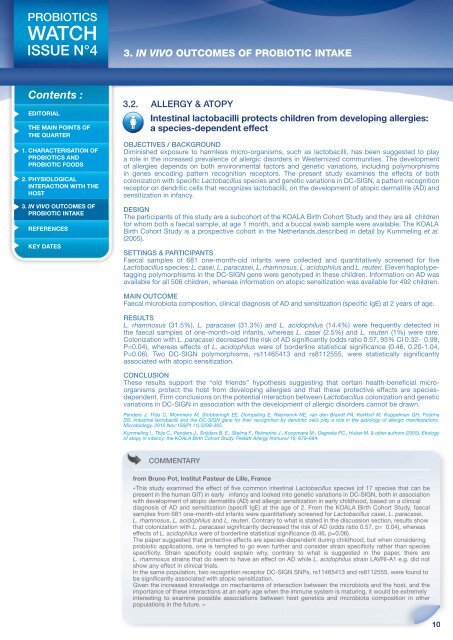PROBIOTICS WATCH - Probiotics In Practice
PROBIOTICS WATCH - Probiotics In Practice
PROBIOTICS WATCH - Probiotics In Practice
You also want an ePaper? Increase the reach of your titles
YUMPU automatically turns print PDFs into web optimized ePapers that Google loves.
<strong>PROBIOTICS</strong><br />
<strong>WATCH</strong><br />
ISSUE N°4<br />
Contents :<br />
EDITORIAL<br />
THE MAIN POINTS OF<br />
THE QUARTER<br />
1. CHARACTERISATION OF<br />
<strong>PROBIOTICS</strong> AND<br />
PROBIOTIC FOODS<br />
2. PHYSIOLOGICAL<br />
INTERACTION WITH THE<br />
HOST<br />
3. IN VIVO OUTCOMES OF<br />
PROBIOTIC INTAKE<br />
REFERENCES<br />
KEY DATES<br />
3. IN VIVO OUTCOMES OF PROBIOTIC INTAKE<br />
3.2. ALLERGY & ATOPY<br />
<strong>In</strong>testinal lactobacilli protects children from developing allergies:<br />
a species-dependent effect<br />
OBJECTIVES / BACKGROUND<br />
Diminished exposure to harmless micro-organisms, such as lactobacilli, has been suggested to play<br />
a role in the increased prevalence of allergic disorders in Westernized communities. The development<br />
of allergies depends on both environmental factors and genetic variations, including polymorphisms<br />
in genes encoding pattern recognition receptors. The present study examines the effects of both<br />
colonization with specific Lactobacillus species and genetic variations in DC-SIGN, a pattern recognition<br />
receptor on dendritic cells that recognizes lactobacilli, on the development of atopic dermatitis (AD) and<br />
sensitization in infancy.<br />
DESIGN<br />
The participants of this study are a subcohort of the KOALA Birth Cohort Study and they are all children<br />
for whom both a faecal sample, at age 1 month, and a buccal swab sample were available. The KOALA<br />
Birth Cohort Study is a prospective cohort in the Netherlands,described in detail by Kummeling et al.<br />
(2005).<br />
SETTINGS & PARTICIPANTS<br />
Faecal samples of 681 one-month-old infants were collected and quantitatively screened for five<br />
Lactobacillus species: L. casei, L. paracasei, L. rhamnosus, L. acidophilus and L. reuteri. Eleven haplotypetagging<br />
polymorphisms in the DC-SIGN gene were genotyped in these children. <strong>In</strong>formation on AD was<br />
available for all 506 children, whereas information on atopic sensitization was available for 492 children.<br />
MAIN OUTCOME<br />
Faecal microbiota composition, clinical diagnosis of AD and sensitization (specific IgE) at 2 years of age.<br />
RESULTS<br />
L. rhamnosus (31.5%), L. paracasei (31.3%) and L. acidophilus (14.4%) were frequently detected in<br />
the faecal samples of one-month-old infants, whereas L. casei (2.5%) and L. reuteri (1%) were rare.<br />
Colonization with L. paracasei decreased the risk of AD significantly (odds ratio 0.57, 95% CI 0.32- 0.99,<br />
P=0.04), whereas effects of L. acidophilus were of borderline statistical significance (0.46, 0.20-1.04,<br />
P=0.06). Two DC-SIGN polymorphisms, rs11465413 and rs8112555, were statistically significantly<br />
associated with atopic sensitization.<br />
CONCLUSION<br />
These results support the ‘‘old friends’’ hypothesis suggesting that certain health-beneficial microorganisms<br />
protect the host from developing allergies and that these protective effects are speciesdependent.<br />
Firm conclusions on the potential interaction between Lactobacillus colonization and genetic<br />
variations in DC-SIGN in association with the development of allergic disorders cannot be drawn.<br />
Penders J, Thijs C, Mommers M, Stobberingh EE, Dompeling E, Reijmerink NE, van den Brandt PA, Kerkhof M, Koppelman GH, Postma<br />
DS. <strong>In</strong>testinal lactobacilli and the DC-SIGN gene for their recognition by dendritic cells play a role in the aetiology of allergic manifestations.<br />
Microbiology. 2010 Nov;156(Pt 11):3298-305.<br />
Kummeling I., Thijs C., Penders J., Snijders B. E., Stelma F., Reimerink J., Koopmans M., Dagnelie PC., Huber M. & other authors (2005). Etiology<br />
of atopy in infancy: the KOALA Birth Cohort Study. Pediatr Allergy Immunol 16, 679–684.<br />
COMMENTARY<br />
from Bruno Pot, <strong>In</strong>stitut Pasteur de Lille, France<br />
«This study examined the effect of five common intestinal Lactobacillus species (of 17 species that can be<br />
present in the human GIT) in early infancy and looked into genetic variations in DC-SIGN, both in association<br />
with development of atopic dermatitis (AD) and allergic sensitization in early childhood, based on a clinical<br />
diagnosis of AD and sensitization (specifi IgE) at the age of 2. From the KOALA Birth Cohort Study, faecal<br />
samples from 681 one-month-old infants were quantitatively screened for Lactobacillus casei, L. paracasei,<br />
L. rhamnosus, L. acidophilus and L. reuteri. Contrary to what is stated in the discussion section, results show<br />
that colonization with L. paracasei significantly decreased the risk of AD (odds ratio 0.57, p= 0.04), whereas<br />
effects of L. acidophilus were of borderline statistical significance (0.46, p=0.06).<br />
The paper suggested that protective effects are species-dependent during childhood, but when considering<br />
probiotic applications, one is tempted to go even further and consider strain specificity rather than species<br />
specificity. Strain specificity could explain why, contrary to what is suggested in the paper, there are<br />
L. rhamnosus strains that do seem to have an effect on AD while L. acidophilus strain LAVRI-A1 e.g. did not<br />
show any effect in clinical trials.<br />
<strong>In</strong> the same population, two recognition receptor DC-SIGN SNPs, rs11465413 and rs8112555, were found to<br />
be significantly associated with atopic sensitization.<br />
Given the increased knowledge on mechanisms of interaction between the microbiota and the host, and the<br />
importance of these interactions at an early age when the immune system is maturing, it would be extremely<br />
interesting to examine possible associations between host genetics and microbiota composition in other<br />
populations in the future. »<br />
10


